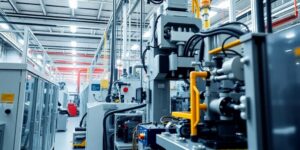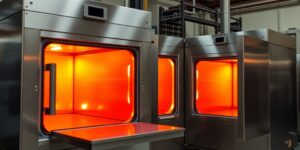Running a busy job shop means every minute counts. When your paint finishing equipment goes down, so does your productivity and your bottom line. Upgrading your gear isn’t just about having the latest tech; it’s about keeping things running smoothly and efficiently. Let’s look at some smart upgrades for your paint finishing equipment that can really cut down on that dreaded downtime.
Key Takeaways
- Automated spray guns give you consistent paint application, reducing rework and saving time.
- Better filtration stops contaminants, which means fewer finish defects and less wasted material.
- Efficient transfer pumps move paint without losing much, saving you money on coatings.
- Smart controls let you monitor and adjust your paint process in real-time, improving output.
- Upgraded fluid handling means fewer clogs and leaks, keeping your paint lines working.
Automated Spray Guns For Consistent Coverage
When you’re running a busy job shop, consistency is king. You need every part that comes off the line to look just as good as the last. That’s where automated spray guns really shine. They take the guesswork out of painting, making sure you get a uniform coat every single time. This level of repeatability means fewer rejects and happier customers.
Benefits of Automated Spray Gun Technology
Using automated spray guns brings a lot to the table. For starters, they drastically cut down on overspray. This means you’re not wasting as much paint, which saves you money. Plus, the consistent application reduces the need for rework. Think about it: less time spent fixing mistakes means more time spent actually painting and shipping orders. It also helps improve the overall finish quality, giving your products a more professional look. It’s a win-win for efficiency and appearance.
Selecting the Right Automated Spray Gun
Choosing the right automated spray gun depends on a few things. You’ll want to consider the type of coatings you use most often. Some guns are better suited for thicker materials, while others excel with thinner finishes. The size of the parts you’re painting also matters. For smaller, intricate pieces, you might need a more precise gun. For larger surfaces, a wider spray pattern might be more efficient. It’s also worth looking into how easily the gun can be integrated with your existing setup. Many modern systems are designed for easy hookup, but it’s always good to check compatibility. Finding the right fit can make a big difference in your daily operations. You can find some great options when you look at robotic painting arms.
Integration with Existing Paint Finishing Equipment
Getting new gear to play nice with your old stuff can sometimes be a headache. But with automated spray guns, integration is usually pretty straightforward. Most systems are designed to connect with standard paint lines and control systems. You might need some adapters or minor adjustments, but it’s generally not a massive overhaul. The key is to plan ahead and make sure the new guns will communicate properly with your existing automation or control panels. This way, you can get them up and running quickly and start seeing those efficiency gains without a huge hassle.
Advanced Filtration Systems to Prevent Contamination

Contamination is a real headache in paint finishing. Little bits of dust, dirt, or even dried paint flakes can get into your system and ruin a perfectly good finish. This means more rework, wasted materials, and unhappy customers. Upgrading your filtration is one of the smartest moves you can make to keep your paint jobs looking sharp and your shop running smoothly. It’s not just about making things look pretty; it’s about preventing costly defects before they even start.
Impact of Air Quality on Finish Defects
Think about it: the air in your shop is constantly moving, especially around the spray booth. If that air isn’t clean, anything floating in it can end up on your freshly painted parts. We’re talking about things like:
- Dust nibs: Tiny particles that create little bumps on the surface.
- Fisheyes: Small, crater-like spots that look like fish eyes.
- Orange peel: A rough, textured surface, often from improper atomization or too much air pressure.
- Solvent popping: Bubbles that form when solvents evaporate too quickly.
These aren’t just cosmetic issues; they often require sanding and recoating, which eats up valuable time and resources. Good air quality is the first line of defense against these problems. It’s amazing how much difference clean air makes to the final product. You can find structured programs to help paint shops reduce downtime through regular inspections and filter maintenance, which is a great idea for any busy shop.
Types of Filtration for Paint Booths
There are a few main types of filters you’ll find in paint booths, and they all play a part in keeping things clean.
- Intake Filters: These are usually the first line of defense, catching dust and debris from the outside air before it even enters the booth. Think of them as the big, coarse filters that grab the obvious stuff.
- Exhaust Filters: These are important for capturing overspray and keeping your shop environment cleaner, but they also help prevent contaminants from recirculating back into the booth if your system isn’t perfectly sealed.
- In-Line Filters: These are placed closer to the spray gun itself, often in the air line. They are typically finer filters designed to catch any remaining small particles or moisture that might have made it through the main intake filters. These are often overlooked but are critical for a flawless finish.
Choosing the right filters depends on your specific setup and the types of coatings you use. Some systems might need multiple stages of filtration for the best results.
Maintenance Schedules for Optimal Performance
Filters don’t last forever. They get clogged up with all the gunk they catch, and when they do, your airflow suffers. This can lead to uneven spray patterns and, you guessed it, more defects. Setting up a regular maintenance schedule is key.
- Check filters weekly: Visually inspect your intake and in-line filters. If they look dirty or clogged, it’s time to swap them out.
- Replace filters monthly (or as needed): This is a general guideline. Depending on your shop’s usage and the environment, you might need to replace them more or less often. Keep an eye on the filter’s condition.
- Document changes: Keep a log of when filters were last changed. This helps you stay on track and identify patterns in filter life.
Sticking to a schedule means your equipment works better and your finishes stay cleaner. It’s a small effort that pays off big time in reduced rework and improved quality. Keeping your filters clean is a simple way to improve your paint jobs.
High-Efficiency Transfer Pumps for Material Savings

Understanding Transfer Pump Efficiency
When you’re running a busy shop, every drop of paint counts. Transfer pumps move paint from the original container to your spray guns. The efficiency of these pumps directly impacts how much paint you actually use versus how much gets wasted. Older or poorly matched pumps can churn air into the paint, cause inconsistent pressure, or simply not move the fluid effectively. This leads to more material being used than necessary and can even affect the quality of your finish. Choosing a pump that’s right for your specific coating and application is key to saving money and reducing waste. Think about the viscosity of the paints you use most often. Thicker paints need more power to move, and a pump that’s struggling will just waste energy and paint.
Choosing Pumps for Different Coating Types
Not all coatings are created equal, and neither are pumps. You’ve got everything from thin lacquers to thick epoxies, and each has different requirements. For water-based coatings, you might need a pump that handles them without issues, avoiding corrosion or contamination. Solvent-based paints might require different seals or materials. High-solids coatings, like some industrial enamels, demand pumps with higher displacement to push that thicker material. It’s important to match the pump’s wetted parts to the chemicals in your paint. Some pumps are designed for general use, while others are specialized. For instance, a diaphragm pump might be good for certain materials, but a piston pump could be better for others. Getting this right means less strain on the equipment and a more consistent feed to your spray guns.
Reducing Material Waste with Upgraded Pumps
Upgrading your transfer pumps can make a surprising difference in your bottom line. A pump that delivers a steady, consistent pressure means your spray guns operate at their best. This leads to better atomization and transfer efficiency, meaning more paint lands on the part and less goes into the overspray. You’ll notice fewer call-backs for finish defects caused by inconsistent paint flow. Plus, when a pump is working efficiently, it’s less likely to break down. This means less downtime for repairs and more time actually painting. It’s a simple change that pays off in material savings and improved productivity. Consider pumps with features like “dead-heading” protection, which stops the pump if the line is blocked, preventing unnecessary wear and tear.
Smart Control Systems for Process Optimization
Keeping a busy job shop running smoothly means more than just having good equipment; it means having equipment that talks to itself and to you. Smart control systems are changing the game for paint finishing. They let you see what’s happening with your paint lines in real-time, making it easier to spot problems before they cause big delays. These systems help you fine-tune your processes for better results and less waste.
Real-Time Monitoring of Paint Finishing Equipment
Think of these systems as the eyes and ears for your entire paint operation. They hook up to your spray guns, pumps, and booth controls, giving you a live feed of how everything is performing. You can track things like fluid pressure, air flow, and even the temperature inside the booth. This kind of information is gold for keeping things consistent. If a spray gun starts acting up, you’ll know right away, not after you’ve already finished a batch of parts with a bad finish. This kind of visibility is key to maintaining high standards in industrial finishing systems.
Data-Driven Adjustments for Improved Output
Once you’re getting all this data, the real magic happens. Smart controls can analyze it and suggest or even make automatic adjustments. For example, if the humidity in the shop changes, the system might tweak the air flow in the booth to keep the paint drying just right. This means fewer runs are ruined by environmental factors. It’s about using the information you have to make smarter decisions, leading to more good parts and less rework. This helps improve overall efficiency.
Remote Diagnostics and Troubleshooting Capabilities
One of the biggest headaches in any shop is when something breaks down unexpectedly. Smart control systems can often tell you what’s wrong without you even having to be there. They can send alerts to your phone or computer, sometimes even diagnosing the issue. This means you can often get a technician on the phone with the right information before they even arrive, or maybe even fix it yourself with clear instructions. This cuts down on the time spent figuring out what went wrong, getting you back to painting faster. It’s a big help for reducing downtime.
Ergonomic Spray Booth Enhancements
When you’re running a busy job shop, the people using the equipment are just as important as the equipment itself. Making the spray booth a better place to work can really cut down on fatigue and mistakes. Think about it: if your painters are more comfortable, they’re likely to do a more consistent job, and that means fewer reworks. Upgrading the booth’s ergonomics isn’t just about comfort; it’s a smart move for productivity.
Improving Operator Comfort and Safety
Long hours in a spray booth can take a toll. Things like vibration from the spray guns, awkward postures, and poor lighting can lead to physical strain and even long-term injuries. Simple changes can make a big difference. Consider adding anti-fatigue mats on the floor – they really help reduce leg and back strain. Also, look at the seating or standing options available. Are they adjustable? Do they support good posture? Safety is also a big part of this. Making sure ventilation is top-notch and that personal protective equipment (PPE) is readily available and easy to use is key. A well-designed booth helps keep your team safe and feeling good, which translates directly to better work. You might want to check out some of the latest spray booth designs that focus on operator well-being; they often incorporate features that make the job easier.
Optimizing Airflow for Reduced Overspray
Getting the airflow right in a spray booth is a balancing act. You need enough air movement to pull away fumes and overspray, but too much can cause turbulence and actually increase the amount of paint that misses the target. This wasted paint, or overspray, not only costs money but also makes a mess. Properly designed airflow patterns, often achieved through strategic placement of air inlets and exhaust points, can create a smoother, more predictable environment. This helps the paint particles travel more directly to the part, reducing the amount of material that ends up on the booth walls or in the filters. Some modern booths use variable speed drives on fans, allowing you to fine-tune the airflow based on the specific job or coating being applied. This kind of control can lead to significant material savings over time. For instance, a well-managed airflow system can help you save up to 35% on powder usage in certain applications, according to some industry reports.
Lighting Upgrades for Better Visibility
Bad lighting is a common complaint in many older spray booths. If painters can’t see what they’re doing clearly, they’re more likely to miss spots, apply uneven coats, or even spray the wrong areas. Upgrading to bright, even lighting, often using LED fixtures specifically designed for paint booths, makes a huge difference. This type of lighting provides excellent color rendering, so painters can accurately judge the finish. It also reduces shadows and glare, giving a clear view of the entire workpiece. Think about how much easier it is to work when you can see every detail. Better visibility means fewer errors and a higher quality finish, which is exactly what you want in a busy shop. Making sure your lighting is up to par is a straightforward way to boost both quality and efficiency.
Reliable Fluid Handling and Delivery Solutions
When your paint shop is humming along, the last thing you want is for your fluid delivery system to go on strike. It’s not just about the paint itself; it’s about how it gets from the drum to the spray gun. Messy hoses, clogged lines, or inconsistent flow can really mess up your finish and slow you down. Upgrading your fluid handling and delivery solutions is a smart move for keeping things running smoothly.
Hose and Fitting Durability Considerations
Think about the hoses and fittings you’re using. Are they built for the kind of pressure and chemicals your paint job throws at them? Cheap stuff can crack, leak, or just not hold up over time, leading to unexpected downtime. You need hoses that are resistant to solvents and abrasion, and fittings that create a solid seal. It’s worth looking into materials like PTFE or specialized rubber compounds for hoses, and stainless steel or brass for fittings, depending on your specific coating. Getting the right hose and fittings means fewer headaches down the road.
Preventing Clogs and Leaks in Delivery Lines
Clogs and leaks are the bane of any paint operation. Clogs usually happen when paint dries in the lines, often because the system isn’t flushed properly or there are dead spots where paint can sit. Leaks can come from worn-out seals, damaged hoses, or improperly tightened fittings. Regular maintenance is key here. Make sure your lines are purged thoroughly after each use, and inspect them regularly for any signs of wear or damage. Some systems have built-in strainers that can catch debris before it causes a problem.
Ensuring Consistent Paint Flow to the Applicator
Your spray gun needs a steady, consistent supply of paint to work its best. If the pressure or volume fluctuates, you’ll see variations in your spray pattern, which means more rework. This is where a good transfer pump and pressure regulator come into play. They work together to maintain the correct paint flow, regardless of what’s happening elsewhere in the system. It’s all about giving your applicator the stable conditions it needs to produce a quality finish, every single time.
Need dependable ways to move and supply fluids? We offer top-notch systems designed for just that. Our solutions ensure your fluids get where they need to go, safely and efficiently. Explore our range of products and find the perfect fit for your needs. Visit our website today to learn more!
Wrapping Up Your Equipment Upgrade
So, we’ve talked about a few ways to upgrade your paint finishing gear. It might seem like a big job, but think about how much time you’ll save. Less downtime means more jobs get done, and that’s good for business. Plus, newer equipment often works better, giving you a cleaner finish. It’s not just about new toys; it’s about making your shop run smoother. Take a look at what you have now and see where the biggest headaches are. A smart upgrade can really make a difference in your day-to-day work. You’ll probably wonder why you didn’t do it sooner.
Frequently Asked Questions
Why are automatic spray guns better for painting jobs?
Upgrading to automatic spray guns means you get the same great paint coat every time. This helps avoid mistakes and saves you from redoing the job. It’s like having a robot painter that never gets tired and always does it right.
How do better filters help my paint jobs look good?
Clean air is super important! If dirt or dust gets into the paint, it can ruin the finish, making it look bumpy or messy. Better filters keep the air clean, so your paint jobs look smooth and professional.
What’s the big deal with efficient paint pumps?
Think of transfer pumps like a strong arm that pushes paint. High-efficiency pumps use less energy to move the same amount of paint. This means you save money on paint because less is wasted, and it gets to where it needs to go smoothly.
How can smart controls help my painting setup?
Smart controls are like a brain for your painting machines. They watch everything happening in real-time, like how much paint is being used or if a machine is running too hot. This helps fix problems before they get big and makes the whole painting process work better.
How do changes in the spray booth help the people working in it?
Making the paint booth comfy and safe for workers is key. Better airflow means less paint mist floating around, which is healthier. Good lighting helps painters see exactly what they’re doing, leading to fewer errors and happier workers.
Why is it important to have good hoses and connections for paint?
The hoses and connections that carry paint need to be tough. If they leak or get blocked, it stops the paint flow. Making sure these parts are strong and reliable means the paint keeps moving without any annoying interruptions.





